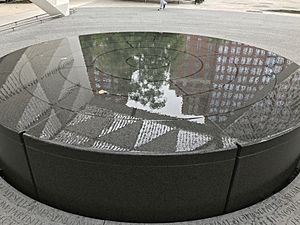New York City AIDS Memorial facts for kids
The New York City AIDS Memorial is a special place in Greenwich Village, Manhattan, New York City. It was built to remember the more than 100,000 people in New York City who died from AIDS. It also celebrates the hard work of the people who cared for them and the activists who fought for change. This memorial is the first big public space in New York City dedicated to the AIDS epidemic. It opened on World AIDS Day, December 1, 2016. The design for the memorial came from almost 500 architects. They imagined an 18-foot steel canopy. This canopy acts as a gateway to the new St. Vincent's Hospital Park in Greenwich Village.
| Top - 0-9 A B C D E F G H I J K L M N O P Q R S T U V W X Y Z |
What is the NYC AIDS Memorial?
The New York City AIDS Memorial is located on a small piece of land shaped like a triangle. This land is where 12th Street, Greenwich Avenue, and Seventh Avenue meet in Greenwich Village. The memorial is next to the former St. Vincent's Hospital. This hospital had the city's first and largest ward for people with AIDS. Many people see this hospital as a very important place in the history of the disease in New York. It is even mentioned in famous books and plays like The Normal Heart and Angels in America. These stories help tell about the time when many people were sick in New York.
The memorial has an 18-foot (about 5.5 meter) high steel canopy. This canopy covers an area of about 1,600 square feet (about 149 square meters). The structure is made up of many triangles of different sizes. Three large triangles act as legs, connecting to two even bigger triangles at the top. This makes it look a bit like an open airplane. Each of the triangles is filled with 16 smaller triangles. All of them have lines that look like air vents. These lines light up at night, making the memorial glow.
How the NYC AIDS Memorial Was Created
In November 2011, the NYC AIDS board announced a worldwide design competition. They worked with Architectural Record magazine and the Architizer website. The goal was to find the best design for the memorial park. A team from Brooklyn, called Studio a+i, won the competition. This team was led by Mateo Paiva, Lily Lim, and Esteban Erlich. They became the architects for the memorial park.
The memorial also includes special artwork by Jenny Holzer. She had the idea to engrave lines from Walt Whitman's poem "Song of Myself" onto a granite panel. This adds another layer of meaning and beauty to the memorial.



